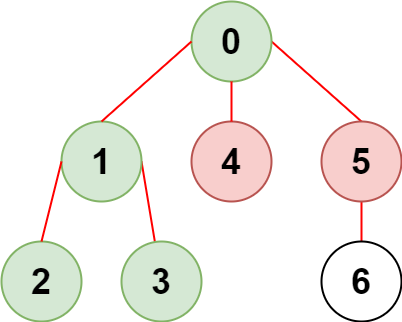Problem
There is an undirected tree with n nodes labeled from 0 to n - 1 and n - 1 edges.
You are given a 2D integer array edges of length n - 1 where edges[i] = [ai, bi] indicates that there is an edge between nodes ai and bi in the tree. You are also given an integer array restricted which represents restricted nodes.
Return **the *maximum* number of nodes you can reach from node 0 without visiting a restricted node.**
Note that node 0 will not be a restricted node.
Example 1:

Input: n = 7, edges = [[0,1],[1,2],[3,1],[4,0],[0,5],[5,6]], restricted = [4,5]
Output: 4
Explanation: The diagram above shows the tree.
We have that [0,1,2,3] are the only nodes that can be reached from node 0 without visiting a restricted node.
Example 2:

Input: n = 7, edges = [[0,1],[0,2],[0,5],[0,4],[3,2],[6,5]], restricted = [4,2,1]
Output: 3
Explanation: The diagram above shows the tree.
We have that [0,5,6] are the only nodes that can be reached from node 0 without visiting a restricted node.
Constraints:
2 <= n <= 10^5edges.length == n - 1edges[i].length == 20 <= ai, bi < nai != biedgesrepresents a valid tree.1 <= restricted.length < n1 <= restricted[i] < nAll the values of
restrictedare unique.
Solution (Java)
class Solution {
public int reachableNodes(int n, int[][] edges, int[] restricted) {
List<Integer>[] graph = new ArrayList[n];
for (int i = 0; i < n; i++) {
graph[i] = new ArrayList<>();
}
for (int[] edge : edges) {
int src = edge[0];
int dest = edge[1];
graph[src].add(dest);
graph[dest].add(src);
}
Queue<Integer> q = new ArrayDeque<>();
boolean[] visited = new boolean[n];
q.offer(0);
visited[0] = true;
for (int node : restricted) {
visited[node] = true;
}
int ans = 0;
while (!q.isEmpty()) {
int vertex = q.poll();
ans++;
for (int neighbour : graph[vertex]) {
if (!visited[neighbour]) {
q.offer(neighbour);
visited[neighbour] = true;
}
}
}
return ans;
}
}
Explain:
nope.
Complexity:
- Time complexity : O(n).
- Space complexity : O(n).